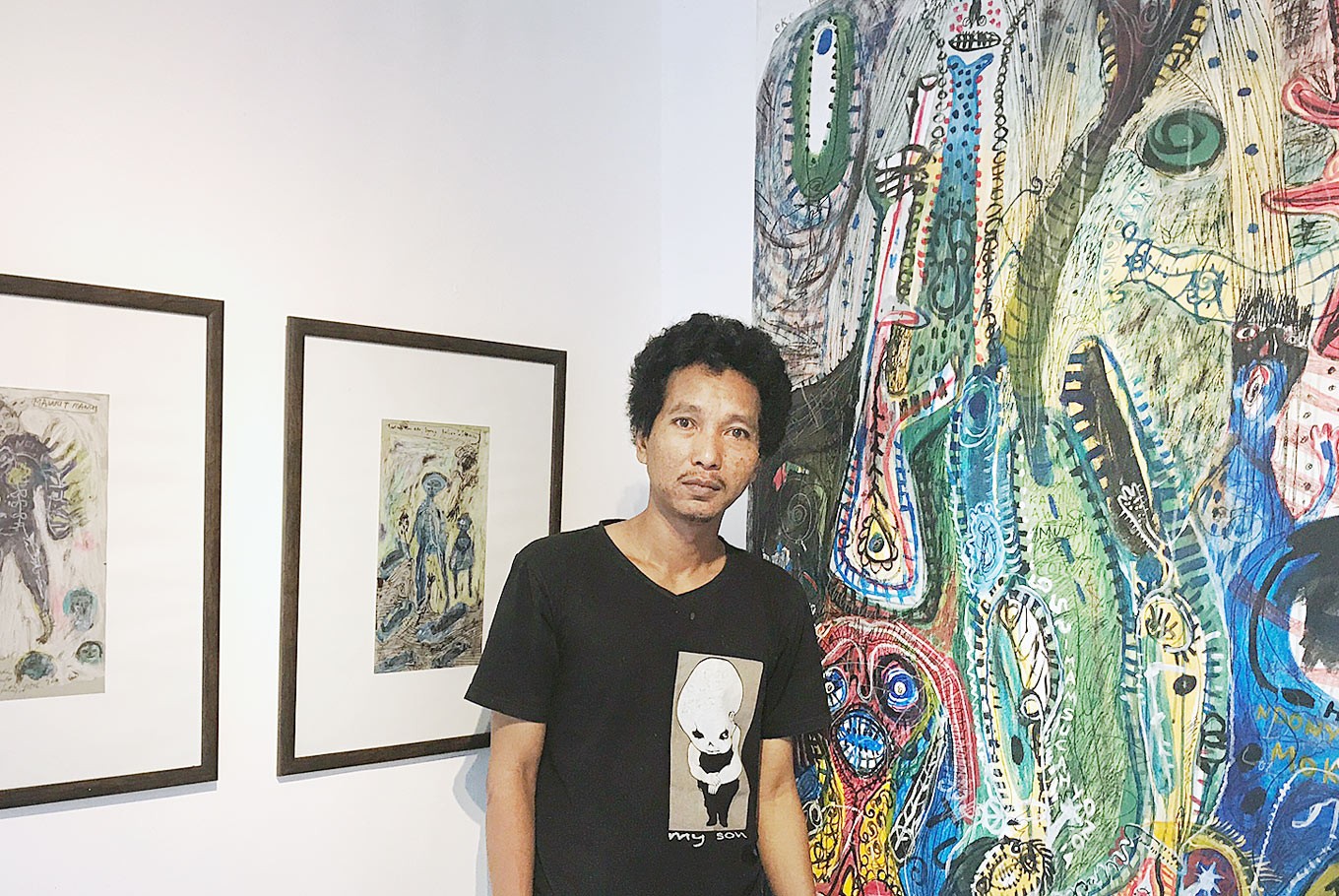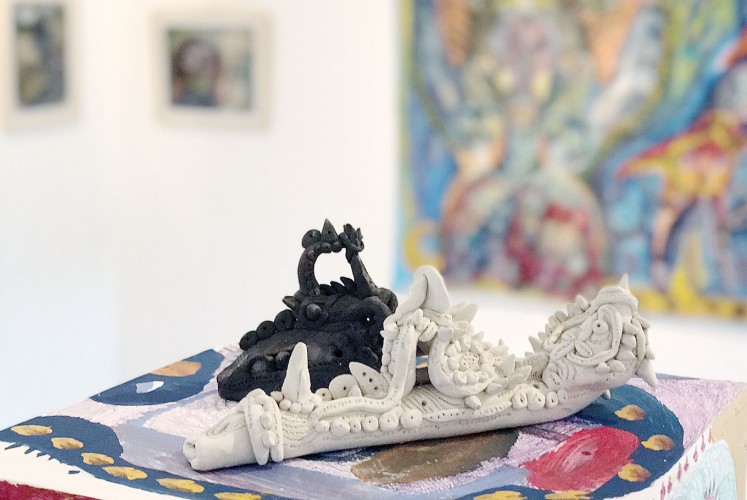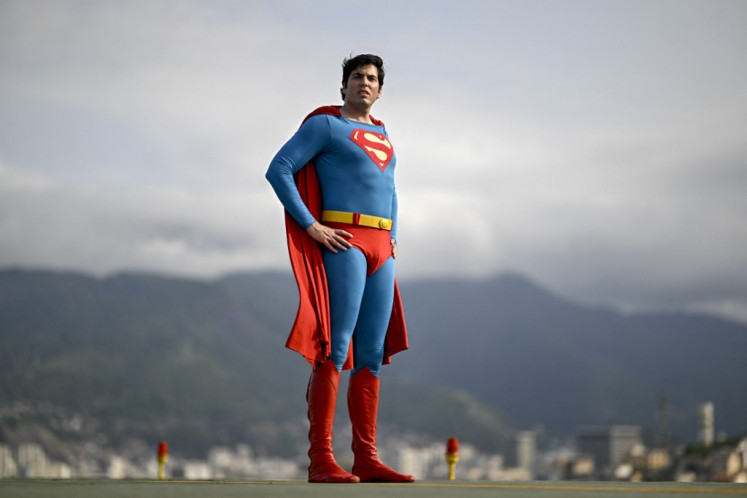The esthetically chaotic world of Imam Sucahyo
A self-taught artist reveals his soul-searching journey through works of chaotic realms, mythical beasts and vulnerable hearts.
Change Size
 In person, Imam Sucahyo does not exude the restlessness and vigor often associated with a visual artist. (JP/I Wayan Juniarta)
In person, Imam Sucahyo does not exude the restlessness and vigor often associated with a visual artist. (JP/I Wayan Juniarta)
I
n person, Imam Sucahyo does not exude the restlessness and vigor often associated with a visual artist. A lean man with unkempt hair, he is a man of few words, the kind of a person who could walk across a crowded room unnoticed.
“My friends think I am a humorous guy, I don’t know why,” the 39-year-old man said with a faint smile.
His humorous streak, however, is apparent in the words he scribbles on his works. In several paintings falling under the “Salon Period”, referring to works created while he was working as a hairstylist at a beauty parlor, he writes hilarious slang words often used by transwomen, many of whom worked at the beauty parlor.
More than 100 paintings, drawings and sketches created by Imam are now on display at his inaugural solo exhibition “Jagat Mawut” (Chaotic World) at Cata Odata, a progressive gallery in Penestanan, Ubud. The exhibit also offers Scene to Scene, a guided tour with the artist and the curator, a documentary film screening and an art discussion.
Read also: Imam Sucahyo's Outsider Art electrifies in inaugural solo exhibit

Imam showed an artistic inclination early in his childhood. He started making dolls and drawing when he was in elementary school in Tuban, East Java. Yet, becoming a painter was never his aspiration.
“It was just because I like to do that. Drawing gives me joy,” he recalled.
A senior painter, Sareh Karsadi was living next door and the young Imam spent hours and hours watching the artist at work, observing his brush strokes and immersing himself in the brilliant colors that gradually took over the canvas.
“He never taught me how to paint, I believe he wanted me to be free from any influence and I learned how to paint all by myself,” he recalled.
A book on fine art that Little Imam chanced upon in the school library introduced him to the works of two of Indonesia’s greatest painters, Raden Saleh and Affandi. The book further reinforced his love of painting.
“Affandi really influenced me at that time. I drew [in his style] and pinned the drawing on the wall of my room.”
Soon painting became his primary passion and first priority while his daily, “regular” job took a backseat.
“If a job started to disrupt my painting, then I would leave it,” he says.

Imam’s works are perceived by many as fine examples of Art Brut (raw art) or Outsider Art, which refer to art created by self-taught or naïve artists, who are on the outside of the established art scene. The terms can have a disparaging or encouraging meaning, depending on the perspective.
Perceiving Imam’s works simply as fine examples of Art Brut or Outsider Art, however, would rob any art lovers of the opportunity to be awed not only by their esthetic quality but, more importantly, by their deep symbolism.
“These [works] are the results of my keluyuran [wandering aimlessly]. Usually, upon returning home from keluyuran, I sit and start painting,” he said.
Keluyuran provides Imam with a chance to explore new places and meet new people. It is a cathartic experience as he found out that humans, despite their differences, actually share the same suffering and fight the same struggles. This experience has led him to a deeper understanding of his fellow human beings and, therefore, of himself.

His work entitled Urip Nandur Apik Mati Mesem (Sowing Good Deeds in Life Leads to a Peaceful Death) is a testament to this understanding. A juxtaposition of anthropomorphic figures with transparent torsos revealing internal organs, beasts and plants, as well as wise words in Javanese, the work beautifully captures Imam’s realization about the interconnectivity of beings: Being kind to each other and to all creatures is the only way to achieve inner peace.
It is also one of the finest examples of Imam’s visual signature; the ability to weave colors and minuscule details into gorgeous, albeit chaotic shapes and patterns, which at a glimpse give his works a Batik-esque appearance.
Yet, after more than 15 years of painting, Imam is still too timid to claim that his works are a message to his fellow human beings. The works, he stressed, are his visual soliloquy.
“My works are the results of my dialogue with myself. Their messages are for me and those messages are not about how to achieve happiness in this life, but about how to learn to abate life’s disappointment.”









